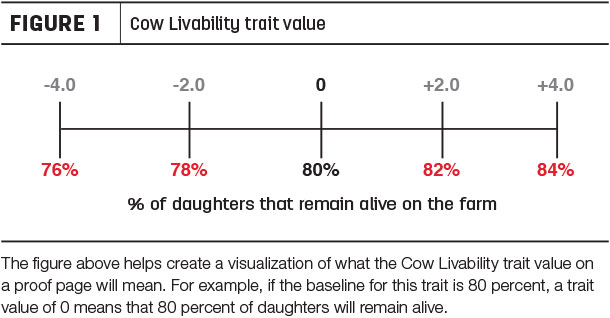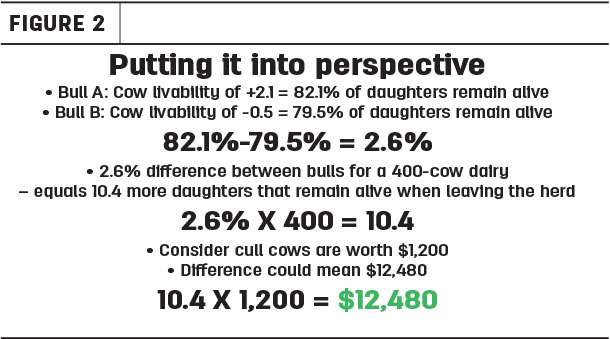Consider the scenario of a cow leaving the milking herd. Culling a cow can sometimes be a good situation when she is sold for reasons like poor production, fertility issues, health challenges or overstocked pens, thus allowing your best cows to thrive. But what about when a cow leaves the milking herd because she died?
There is a substantial difference to the bottom line of the dairy farm when a cow can leave under her own power, compared to if she were to die on the farm. This undesirable situation results in a loss of income and other associated costs. Therefore, breeding for cows that are genetically more likely to stay alive in the herd creates a better scenario for both farmer and cow.
The Council on Dairy Cattle Breeding (CDCB) published a new trait in the August genetic evaluations to capture this situation with a trait called Cow Livability (LIV). This new Predicted Transmitting Ability for Cow Livability (PTA LIV) will predict the cow’s ability to remain alive in the herd.
This may seem very similar to Productive Life (PL), but in contrast, PL measures how long a cow will last in the herd before she is either culled or dies. LIV has a .70 correlation with PL, which is low enough to justify a separate trait to make progress.
Like other health and fertility traits, LIV will have a low heritability of 1.3 percent, but will have a surprisingly high reliability because of the collection of termination codes in the national database for decades, thus giving genomic-only young bulls an average reliability of 56 percent. This trait will be available for all breeds and it is important to note that each breed is compared against itself.
What does the Cow Livability value mean?
Cow mortality is a real situation that will be confronted with this new trait. Consider on average, 7 percent of cows each lactation will die on the average farm, and the average lactations per cow is 2.8, resulting in approximately 20 percent of cows to be claimed by death on the average farm during their lifetime. In contrast, 80 percent of cows will remain in the milking herd until they are disposed of profitably.
If the value of 80 percent is used as the baseline for the genetic evaluation, a bull with an evaluation for LIV of +2.1 will sire 82.1 percent of his daughters that will remain alive, while a bull that is -0.5 will have 79.5 percent of his daughters that will remain alive (Figure 1).

To put this into perspective, this 2.6 percent difference in a 400-cow dairy with $1,200 cull cows would produce $12,480 in additional income (Figure 2).

Keep in mind that because your farm might not match the base value for livability, it is better to use this trait as a tool to compare sires to each other rather than to compare a sire to the PTA base.
In addition, management and environment vastly impact the state of cows that leave the herd, but considering all of those factors equal, progress is possible at the genetic level. This advantage will be noticed over time and across many records in the herd.
LIV was not included in the USDA economic indexes yet in August, but will potentially be included in future evaluations. Previous to the introduction of LIV, we did not have a sufficient way to measure which cows left the herd under their own power. Obviously, being able to measure this situation has great economic value.
Figure 1 helps create a visualization of what the Cow Livability trait value on a proof page will mean. For example, if the baseline for this trait is 80 percent, a trait value of 0 means 80 percent of daughters will remain alive.
Figure 2 puts into perspective what the difference between a bull with a +2.1 Cow Livability value and a bull with a -0.5 Cow Livability trait value could mean for a 400-cow dairy. ![]()
Michael Schmitt is a genetics information analyst with Accelerated Genetics. Email Michael Schmitt.





